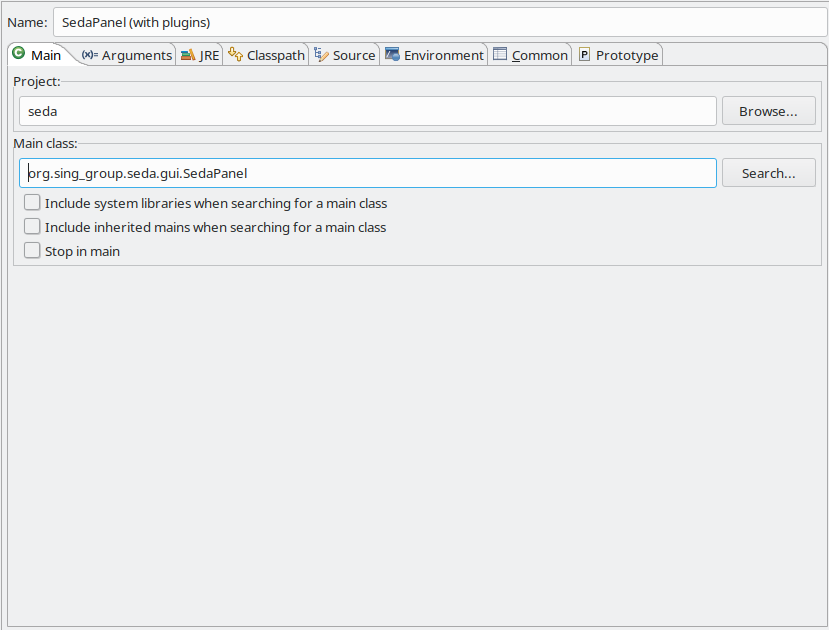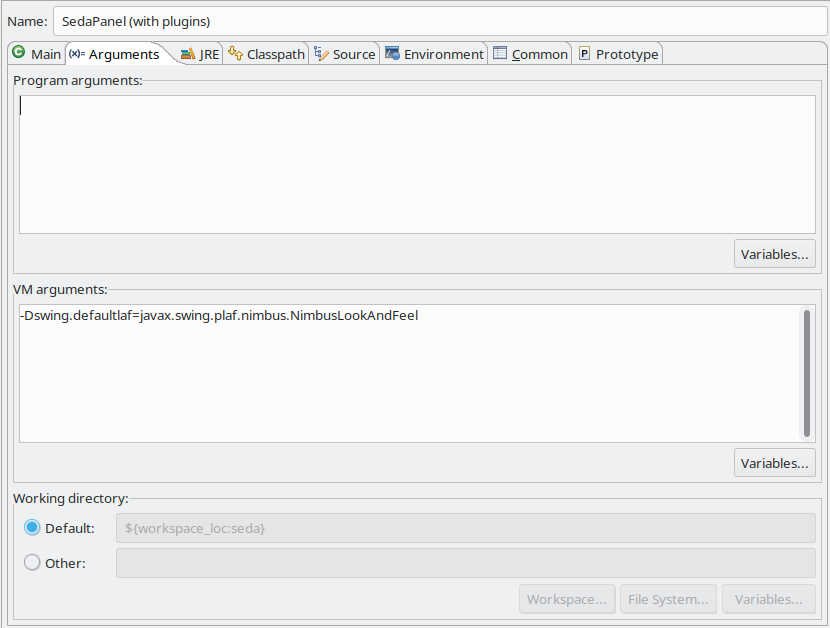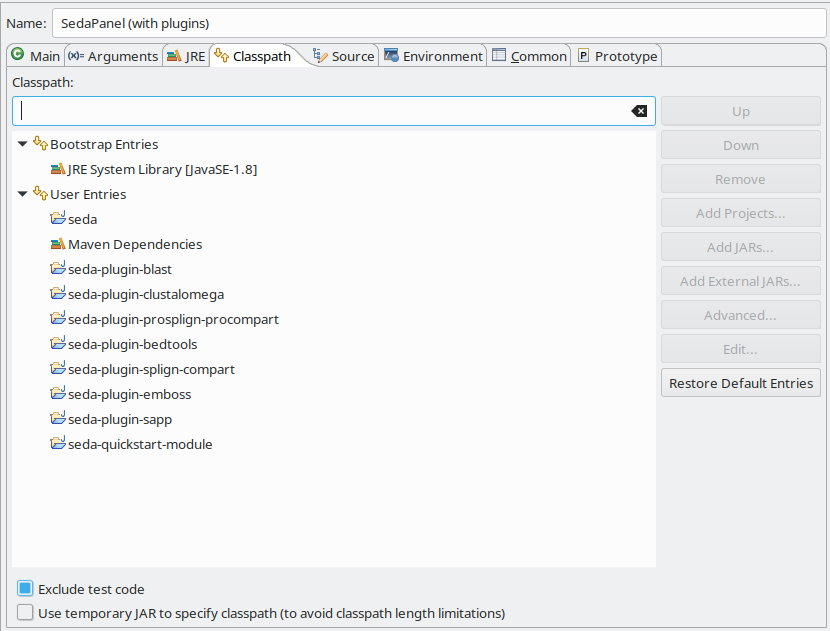Developers¶
This section provides an overview on the most important topics for developers of SEDA operations.
Basic concepts¶
The processing of sequences in SEDA is built around the idea of ’transformations’. A transformation receives a sequence, a group of sequences (e.g. a FASTA file) or a dataset (a set of FASTA files) and returns a transformed item of the same type (i.e. a sequence if it receives a sequence as input).
The interface Sequence represents a single DNA or protein sequence and objects of this class can be transformed using a SequenceTransformation.
The interface SequencesGroup represents a group of Sequence objects and objects of this class can be transformed using a SequencesGroupTransformation. Objects of this class also store a map of properties which is used to keep information regarding the entire set of sequences (e.g. SEDA uses it to store the line break type when reading them from FASTA files).
The interface SequencesGroupDataset represents a set of SequencesGroup objects of this class can be transformed using a SequencesGroupDatasetTransformation.
Each of the three operation interfaces has ’concat’ methods to concatenate operations of their corresponding types. In addition, two implementations are provided:
- An implementation of
SequencesGroupTransformationcalledComposedSequencesGroupTransformation, which allows applying severalSequenceTransformationto all the sequences in a sequences group. - An implementation of
SequencesGroupDatasetTransformationcalledComposedSequencesGroupDatasetTransformation, which allows applying severalSequencesGroupTransformationto all the sequence groups in a dataset.
These two transformation are useful to create SEDA operations as the Operations and plugins section explains.
The DatatypeFactory (Abstract Factory pattern)¶
All transformations implemented in SEDA receive in their constructors an object that implements the DatatypeFactory interface. This interface defines several methods to build Sequence, SequenceGroup and SequencesGroupDataset objects.
SEDA has two implementations of this interface and uses one of them when requesting the SequencesGroupDatasetTransformation objects to the corresponding TransformationProvider objects (see the Operations and plugins section for more details about this).
By one hand, the InDiskDatatypeFactory processes sequences from files instead of having their contents in memory. If a SequencesGroup is created from a FASTA file, then this factory creates an object of class InDiskSequencesGroup that stores objects of class InDiskSequence that retrieve the sequence contents from the original file every time they are requested using a RandomAccessFile. Also, if a InDiskSequence is created by passing the header and nucleotide or amino acid chain to its constructor (or using the InDiskSequence::newSequence method), this class stores the sequence into a temporary file and does the same. This class is aimed to allow processing big datasets in computers with a low amount of RAM memory available.
On the other hand, the InMemoryDatatypeFactory uses implementations like InMemorySequencesGroup and InMemorySequence that keep the sequence contents in memory.
It is important to note that both factories can be created using a charsetSupportEnabled parameter. When the no-args constructor is used, this is set to false, which means that SEDA will use a fast loading algorithm that works with most of the FASTA files without special characters. When set to true, SEDA will try to automatically identify the charset used by each FASTA file before loading them, resulting in a slower processing. This option should be used only if the input FASTA file contain special characters or SEDA have failed to load them.
Writing and reading FASTA files¶
The FastaWriter class provides different methods to write collections of Sequence objects into files using the FASTA format. These methods allows specifying the charset, the line break character, and whether the output must be compressed in gzip or not.
In the other hand, the FastaReader class provides different methods to parse FASTA files and retrieve an stream of Sequence objects. There are two versions of the readFasta method, one receiving a SequenceFromTextBuilder object and another one receiving an SequenceFromLocationsBuilder object. The former, which is used by the InMemorySequencesGroup class, parses the file loading their contents in memory and invokes the create method of the SequenceFromTextBuilder object each time a complete sequence has been parsed. The latter, which is used by the ÌnDiskSequencesGroup class, parses the file indexing the positions of each sequence in the input file and invokes the the create method of the SequenceFromLocationsBuilder object each time a complete sequence has been parsed and indexed.
Operations and plugins¶
SEDA operations (i.e. a specific manipulation of sequences) are provided by objects of class type SedaGuiPlugin. This interface requires classes implementing operations to provide:
- A name for the operation.
- A name for the group of the operation, which SEDA’s GUI uses to group operations in the selection menu.
- A GUI component to show in the SEDA’s GUI to allow users to configure the operation.
- A
TransformationProviderwhich must provide aSequencesGroupDatasetTransformationto transform a dataset.
Due to the latter requirement, the aforementioned implementations (ComposedSequencesGroupDatasetTransformation and ComposedSequencesGroupTransformation) are specially useful. For instance, they facilitate the creation of an operation that manipulates only one sequence at a time (e.g. removing stop codons) in a class that implements the SequenceTransformation interface and then wrapping it using them to provide the required SequencesGroupDatasetTransformation.
SequenceTransformation mySequenceTransformation = new RemoveStopCodonsTransformation();
SequencesGroupDatasetTransformation transformation =
new ComposedSequencesGroupDatasetTransformation(
new ComposedSequencesGroupDatasetTransformation(
mySequenceTransformation
)
);
The SedaContext¶
The SedaGuiPlugin interface also requires to implement the method setSedaContext(SedaContext context). This method is used by SEDA to set a SedaContext instance, an object that allows the plugins to get context information from SEDA such as the list of selected FASTA files.
Saving and loading configurations¶
The SedaGuiPlugin interface defines three methods related with saving and loading the configuration of the operations: canSaveTransformation, saveTransformation(File file), and loadTransformation(File file). The SEDA’s GUI ask each plugin whether they can save the current operation configuration into a file or not using the canSaveTransformation method. If so, it uses the other two methods to allow users saving and loading the transformation from a text file.
The AbstractSedaGuiPlugin implements these in order to disable this behaviour, so operations providing this feature must override and implement the three methods. All operations included in SEDA implement these as follows (the example is taken from the MergeGuiSedaPlugin class):
@Override
public boolean canSaveTransformation() {
return true;
}
@Override
public void saveTransformation(File file) throws IOException {
new JsonObjectWriter<MergeTransformationProvider>()
.write(this.panel.getTransformationProvider(), file);
}
@Override
public void loadTransformation(File file) throws IOException {
this.panel.setTransformationProvider(
new JsonObjectReader<MergeTransformationProvider>()
.read(file, MergeTransformationProvider.class)
);
}
Where:
- The corresponding
TransformationProvider(MergeTransformationProviderin this case) has JAXB annotations that make it serializable into XML/JSON. - The
JsonObjectReaderandJsonObjectWriterare used to load or save the concrete transformation provider implementation.
Architecture¶
The SEDA project is composed of several maven modules, being ’seda’ the main module, which contains the core implementations and datatypes, the Service Provider Interfaces (SPIs) to implement the plugins, and the core set of operations (i.e. plugins) provided by SEDA that do not require external dependencies. This module also contains the Graphical User Interface (GUI) of SEDA. Then, the remaining maven modules provide different operations that need external software dependencies (e.g. BLAST or EMBOSS) to run.
How to implement a module¶
Firstly, a new maven module must be added to the project with the ’seda-all’ artifact as parent (Note: use the appropriate version of the project):
<parent>
<groupId>org.sing_group</groupId>
<artifactId>seda-all</artifactId>
<version>1.5.0</version>
<relativePath>../pom.xml</relativePath>
</parent>
Also, the ’seda’ artifact must be added as dependency:
<dependencies>
<dependency>
<groupId>org.sing_group</groupId>
<artifactId>seda</artifactId>
</dependency>
</dependencies>
Secondly, a class that implements the SedaPluginFactory interface must be created. This class is responsible of creating the plugins provided by the module (classes that implement the SedaGuiPlugin interface).
Finally, register the factory implementation in a file named org.sing_group.seda.plugin.spi.SedaPluginFactory at the src/main/resources/META-INF/services/ directory of the module so that SEDA can discover and add them to the user interface.
Section Building the installers explains how to add the module to the SEDA installers.
Section Quick-start module shows how to create a sample module with one plugin.
Running external software¶
In Java, external programs can be executed using Runtime.getRuntime().exec() or ProcessBuilder. The package org.sing_group.seda.core.execution contains several classes to facilitate this labor in SEDA. The most important one is the AbstractBinariesExecutor, which offers different methods to execute commands in different ways. Taking the ’seda-blast’ module as example, the class AbstractBlastBinariesExecutor extends it in order to run the BLAST commands (see also the DefaultBlastBinariesExecutor class).
Therefore, all the SEDA modules use this class to run the required external commands. In addition, all the modules also provide the possibility of running Docker commands, which require to mount the directories referenced in the command when running the image. To facilitate this, the class DockerExecutionUtils provides useful methods. An example of its usage can be found in the DockerBlastBinariesExecutor class of the ’seda-blast’ module.
Building the installers¶
The ’seda-distribution’ directory contains a ’README.md’ file with instructions on how to build the installers and ZIP distributables of SEDA using the ’create-dist.sh’ script.
Adding a new module to the installers¶
Firstly, edit the ’create-dist.sh’ script to copy the jar file of the new module into the ’seda-distribution/target/jars’ directory.
Secondly, edit the run scripts available in the ’run-scripts’ directory to include the jar file of the new module if neccessary.
Developing with Eclipse¶
To develop SEDA modules or plugins with Eclipse, just import the parent project using the ’Import Existing Maven Projects’ option.
Then, to run SEDA from Eclipse, a new ’Run Configuration’ with the following settings can be created. First, in the ’Main’ tab, select the main ’seda’ project and use org.sing_group.seda.gui.SedaPanel as main class.
Secondly, in the the ’Arguments’ tab, use -Dswing.defaultlaf=javax.swing.plaf.nimbus.NimbusLookAndFeel as VM arguments.
And thirdly, in the the ’Classpath’ tab, add the project modules as user entries using the ’Add Projects…’ button.
This configuration will run the SEDA’s GUI with all the modules.
Quick-start module¶
This section guides trough the creation of a quick-start module containing a simple operation for trimming sequences.
1. Setting up the module¶
To get started, clone the source code of SEDA from GitHub:
git clone https://github.com/sing-group/seda.git
Now, create a new folder named ’seda-quickstart-module’ inside the project structure:
mkdir seda-quickstart-module
Then, create a pom.xml file inside this folder with the following content:
<project xmlns="http://maven.apache.org/POM/4.0.0" xmlns:xsi="http://www.w3.org/2001/XMLSchema-instance"
xsi:schemaLocation="http://maven.apache.org/POM/4.0.0 http://maven.apache.org/maven-v4_0_0.xsd"
>
<modelVersion>4.0.0</modelVersion>
<parent>
<groupId>org.sing_group</groupId>
<artifactId>seda-all</artifactId>
<version>1.5.0</version>
<relativePath>../pom.xml</relativePath>
</parent>
<artifactId>seda-quickstart-module</artifactId>
<packaging>jar</packaging>
<name>SEquence DAtaset builder Quick-start Module</name>
<dependencies>
<dependency>
<groupId>org.sing_group</groupId>
<artifactId>seda</artifactId>
</dependency>
</dependencies>
<build>
<plugins>
<plugin>
<groupId>org.apache.maven.plugins</groupId>
<artifactId>maven-assembly-plugin</artifactId>
<configuration>
<descriptorRefs>
<descriptorRef>jar-with-dependencies</descriptorRef>
</descriptorRefs>
<archive>
<manifest>
<addClasspath>true</addClasspath>
<mainClass>org.sing_group.seda.gui.SedaPanel</mainClass>
</manifest>
</archive>
</configuration>
<executions>
<execution>
<phase>package</phase>
<goals>
<goal>single</goal>
</goals>
</execution>
</executions>
</plugin>
<plugin>
<groupId>org.apache.maven.plugins</groupId>
<artifactId>maven-jar-plugin</artifactId>
<configuration>
<archive>
<manifest>
<addClasspath>true</addClasspath>
<mainClass>org.sing_group.seda.gui.SedaPanel</mainClass>
</manifest>
</archive>
</configuration>
</plugin>
<plugin>
<groupId>org.apache.maven.plugins</groupId>
<artifactId>maven-javadoc-plugin</artifactId>
<executions>
<execution>
<id>attach-javadocs</id>
<goals>
<goal>jar</goal>
</goals>
</execution>
</executions>
</plugin>
<plugin>
<groupId>org.apache.maven.plugins</groupId>
<artifactId>maven-source-plugin</artifactId>
<executions>
<execution>
<id>attach-sources</id>
<goals>
<goal>jar</goal>
</goals>
</execution>
</executions>
</plugin>
</plugins>
</build>
</project>
And finally, add it as a module to the <modules> section of the root pom.xml file:
<modules>
<module>seda</module>
<module>seda-plugin-blast</module>
<module>seda-plugin-clustalomega</module>
<module>seda-plugin-prosplign-procompart</module>
<module>seda-plugin-splign-compart</module>
<module>seda-plugin-bedtools</module>
<module>seda-plugin-emboss</module>
<module>seda-plugin-sapp</module>
<module>seda-quickstart-module</module>
</modules>
2. Implementing SequenceTransformation¶
First, lets make a folder for the source code of the transformation module:
mkdir -p seda-quickstart-module/src/main/java/quickstart/transformation
In this package, create a file named TrimSequencesTransformation.java (at seda-quickstart-module/src/main/java/quickstart/transformation) with the following source code in order to create the class that is able to transform Sequence objects by trimming the corresponding DNA or protein sequence.
package quickstart.transformation;
import org.sing_group.seda.datatype.DatatypeFactory;
import org.sing_group.seda.datatype.Sequence;
import org.sing_group.seda.datatype.SequenceBuilder;
import org.sing_group.seda.transformation.TransformationException;
import org.sing_group.seda.transformation.sequence.SequenceTransformation;
public class TrimSequencesTransformation implements SequenceTransformation {
private final SequenceBuilder builder;
private final int leading;
private final int trailing;
public TrimSequencesTransformation(int leading, int trailing) {
this(DatatypeFactory.getDefaultDatatypeFactory(), leading, trailing);
}
public TrimSequencesTransformation(DatatypeFactory factory, int leading, int trailing) {
this.builder = factory::newSequence;
this.leading = leading;
this.trailing = trailing;
}
@Override
public Sequence transform(Sequence sequence) throws TransformationException {
return this.builder.of(
sequence.getName(),
sequence.getDescription(),
trim(sequence.getChain()),
sequence.getProperties()
);
}
private String trim(String chain) {
try {
return chain.substring(leading, chain.length() - trailing);
} catch (IndexOutOfBoundsException e) {
return "";
}
}
}
For instance, this transformation can be used as follows (in a real case, some unit tests to properly test the transformation should be created):
public static void main(String[] args) {
System.err.println(
new TrimSequencesTransformation(1, 2)
.transform(
Sequence.of("Test", "", "ACCTTGG", Collections.emptyMap())
)
.getChain()
);
}
3. Implementing TransformationProvider¶
Now, it is time to implement the TransformationProvider interface in a class that must provide a SequencesGroupDatasetTransformation to transform a dataset.
This interface can be implemented directly or by extending the AbstractTransformationProvider class, which provides a default implementation of the listeners management. Following this latter case, lets create a file named TrimSequencesTransformationProvider.java (at seda-quickstart-module/src/main/java/quickstart/transformation with the following source code:
package quickstart.transformation;
import static quickstart.transformation.TrimSequencesTransformationProvider.TrimSequencesTransformationChangeType.LEADING_CHANGED;
import static quickstart.transformation.TrimSequencesTransformationProvider.TrimSequencesTransformationChangeType.TRAILING_CHANGED;
import org.sing_group.seda.datatype.DatatypeFactory;
import org.sing_group.seda.plugin.spi.AbstractTransformationProvider;
import org.sing_group.seda.plugin.spi.TransformationChangeType;
import org.sing_group.seda.transformation.dataset.ComposedSequencesGroupDatasetTransformation;
import org.sing_group.seda.transformation.dataset.SequencesGroupDatasetTransformation;
import org.sing_group.seda.transformation.sequencesgroup.ComposedSequencesGroupTransformation;
public class TrimSequencesTransformationProvider extends AbstractTransformationProvider {
public enum TrimSequencesTransformationChangeType implements TransformationChangeType {
LEADING_CHANGED, TRAILING_CHANGED
}
private int leading = 0;
private int trailing = 0;
public TrimSequencesTransformationProvider() {}
public int getLeading() {
return leading;
}
public void setLeading(int newValue) {
this.leading = newValue;
fireTransformationsConfigurationModelEvent(LEADING_CHANGED, newValue);
}
public int getTrailing() {
return trailing;
}
public void setTrailing(int newValue) {
this.trailing = newValue;
fireTransformationsConfigurationModelEvent(TRAILING_CHANGED, newValue);
}
@Override
public boolean isValidTransformation() {
return true;
}
@Override
public SequencesGroupDatasetTransformation getTransformation(DatatypeFactory factory) {
return new ComposedSequencesGroupDatasetTransformation(
new ComposedSequencesGroupTransformation(
new TrimSequencesTransformation(factory, leading, trailing)
)
);
}
}
Some notes about this implementation:
- This class acts as a model that keeps the information required to build the transformation, that is, the number of leading and trailing positions to trim.
- The interface requires to implement two methods:
isValidTransformation: which tells whether the transformation configuration is valid or not. In this case, it can be assumed that the configuration is always valid.getTransformation: which is the method where theSequencesGroupDatasetTransformationfor all the input FASTA files must be built. As explained previously, since the transformation being created here operates at the sequence level, theComposedSequencesGroupTransformationandComposedSequencesGroupDatasetTransformationimplementations are used to encapsulate it.
- The
TransformationProviderinterface also requires implementing three methods to register listeners of typeTransformationChangeListener, which are used by SEDA to know when something changes in the transformation configuration. In this case, they are provided by theAbstractTransformationProviderclass.For this reason, the setters make use of thefireTransformationsConfigurationModelEventwhen the values of leading and trailing are changed.
4. Implementing the GUI editor component¶
Before implementing the SedaGuiPlugin interface, one more component is still required: a GUI editor to allow users configuring the transformation.
In this case, a simple component with two text fields for numbers is enough. To keep things simple, this component can be also responsible of holding an instance of the TrimSequencesTransformationProvider and update the values of the two parameters.
Thus, lets create a file named TrimSequencesTransformationEditor.java (at seda-quickstart-module/src/main/java/quickstart/transformation with the following source code. Note that the GC4S (GUI Components for Java Swing; https://github.com/sing-group/GC4S) library is used here to ease the GUI creation as the main SEDA does.
package quickstart.transformation;
import java.awt.BorderLayout;
import java.util.LinkedList;
import java.util.List;
import javax.swing.JPanel;
import javax.swing.event.DocumentEvent;
import org.sing_group.gc4s.event.DocumentAdapter;
import org.sing_group.gc4s.input.InputParameter;
import org.sing_group.gc4s.input.InputParametersPanel;
import org.sing_group.gc4s.input.text.JIntegerTextField;
public class TrimSequencesTransformationEditor extends JPanel {
private static final long serialVersionUID = 1L;
private TrimSequencesTransformationProvider transformationProvider;
private JIntegerTextField leading;
private JIntegerTextField trailing;
public TrimSequencesTransformationEditor(TrimSequencesTransformationProvider transformationProvider) {
this.transformationProvider = transformationProvider;
this.init();
}
private void init() {
this.setLayout(new BorderLayout());
this.add(
new CenteredJPanel(
new InputParametersPanel(getParameters())
), BorderLayout.CENTER
);
}
private InputParameter[] getParameters() {
List<InputParameter> parameters = new LinkedList<>();
parameters.add(getLeadingParameter());
parameters.add(getTrailingParameter());
return parameters.toArray(new InputParameter[parameters.size()]);
}
private InputParameter getLeadingParameter() {
this.leading = new JIntegerTextField(this.transformationProvider.getLeading());
this.leading.getDocument().addDocumentListener(new DocumentAdapter() {
@Override
public void removeUpdate(DocumentEvent e) {
updateValue();
}
@Override
public void insertUpdate(DocumentEvent e) {
updateValue();
}
private void updateValue() {
transformationProvider.setLeading(leading.getValue());
}
});
return new InputParameter(
"Leading:", this.leading, "The number of bases to trim from the beginning of the sequence"
);
}
private InputParameter getTrailingParameter() {
this.trailing = new JIntegerTextField(this.transformationProvider.getTrailing());
this.trailing.getDocument().addDocumentListener(new DocumentAdapter() {
@Override
public void removeUpdate(DocumentEvent e) {
updateValue();
}
@Override
public void insertUpdate(DocumentEvent e) {
updateValue();
}
private void updateValue() {
transformationProvider.setTrailing(trailing.getValue());
}
});
return new InputParameter(
"Trailing:", this.trailing, "The number of bases to trim from the end of the sequence"
);
}
}
5. Implementing SedaGuiPlugin¶
And now, it is time to implement the SedaGuiPlugin interface. This interface can be implemented directly or by extending the AbstractSedaGuiPlugin class, which provides a default implementation of the SedaContext management (see the The SedaContext section for more details about this). Lets create a file named TrimSequencesSedaGuiPlugin.java (at seda-quickstart-module/src/main/java/quickstart/transformation with the following source code:
package quickstart.transformation;
import java.awt.Component;
import org.sing_group.seda.plugin.core.gui.AbstractSedaGuiPlugin;
import org.sing_group.seda.plugin.spi.SedaGuiPlugin;
import org.sing_group.seda.plugin.spi.TransformationProvider;
public class TrimSequencesSedaGuiPlugin extends AbstractSedaGuiPlugin {
private TrimSequencesTransformationProvider transformationProvider;
public TrimSequencesSedaGuiPlugin() {
this.transformationProvider = new TrimSequencesTransformationProvider();
}
@Override
public String getName() {
return "Trim sequences";
}
@Override
public String getGroupName() {
return SedaGuiPlugin.GROUP_GENERAL;
}
@Override
public Component getEditor() {
return new TrimSequencesTransformationEditor(this.transformationProvider);
}
@Override
public TransformationProvider getTransformation() {
return this.transformationProvider;
}
}
As it can be seen, this class holds an instance of the TrimSequencesTransformationProvider created previously and passes it to the GUI editor component.
6. Implementing SedaPluginFactory¶
And finally, a class that implements the SedaPluginFactory interface must be created. This class is responsible of creating the plugins provided by the module, the TrimSequencesSedaGuiPlugin in this case.
Lets create a file named QuickStartSedaGuiPluginFactory.java (at seda-quickstart-module/src/main/java/quickstart/ with the following source code:
package quickstart;
import java.util.stream.Stream;
import org.sing_group.seda.plugin.spi.SedaCliPlugin;
import org.sing_group.seda.plugin.spi.SedaGuiPlugin;
import org.sing_group.seda.plugin.spi.SedaPluginFactory;
import quickstart.transformation.TrimSequencesSedaGuiPlugin;
public class QuickStartSedaGuiPluginFactory implements SedaPluginFactory {
@Override
public Stream<SedaGuiPlugin> getGuiPlugins() {
return Stream.of(new TrimSequencesSedaGuiPlugin());
}
@Override
public Stream<SedaCliPlugin> getCliPlugins() {
return null;
}
}
It is neccessary to register this implementation in a file named org.sing_group.seda.plugin.spi.SedaPluginFactory at the src/main/resources/META-INF/services/ directory of the module so that SEDA can discover and add its plugins to the user interface.
mkdir -p src/main/resources/META-INF/services/
echo "quickstart.QuickStartSedaGuiPluginFactory" > src/main/resources/META-INF/services/org.sing_group.seda.plugin.spi.SedaPluginFactory
To test the new module, simply run the SEDA’s GUI with the module loaded. The Developing with Eclipse section explains how to do it using this IDE. Otherwise, section Building the installers explains how to add the module to the SEDA installers.



